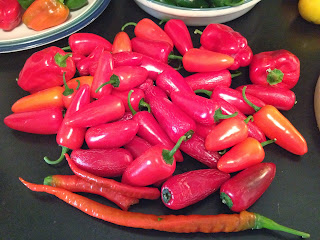Chipotle Corn Chowder

The day before Thanksgiving is Pie Day, but in addition to the traditional baking (pumpkin and apple, which I can share later), I also made a soup for Thanksgiving lunch. I have been ruminating about using our frozen corn for a corn chowder for a few months now, and this seemed the perfect day to give it a go. Corn, after all, is a pretty traditional New England Thanksgiving food. For us, though, it has always been a challenge to grow , so using the last of our hard-won kernels warranted a special occasion. My recipe is modified from Pioneer Woman's Corn Chowder with Chilies [sic]. I liked the idea of spicing this up, but I went with our own dried chipotles instead of the canned ones called for in the recipe. Vinegary, canned peppers seemed weird to me in a creamy soup, but her addition of masa harina is genius. Here's my version: Chipotle Corn Chowder 4 slices of bacon (ours was from Tendercrop and was corn-cob smoked, which is extra smoky and rich-tasting, ...










